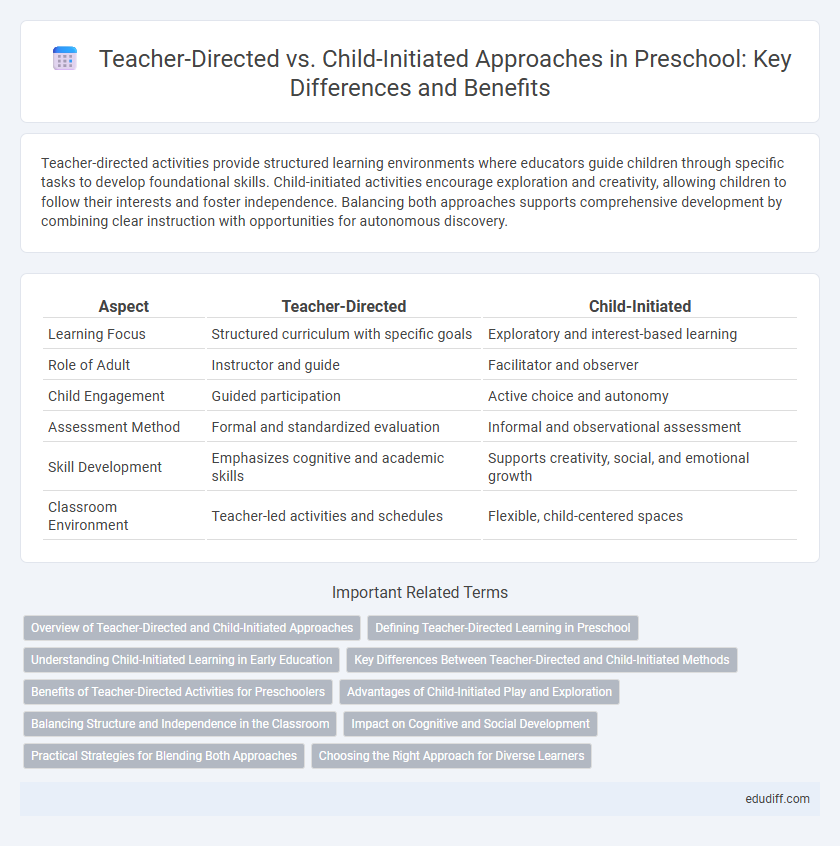Teacher-directed activities provide structured learning environments where educators guide children through specific tasks to develop foundational skills. Child-initiated activities encourage exploration and creativity, allowing children to follow their interests and foster independence. Balancing both approaches supports comprehensive development by combining clear instruction with opportunities for autonomous discovery.
Table of Comparison
| Aspect | Teacher-Directed | Child-Initiated |
|---|---|---|
| Learning Focus | Structured curriculum with specific goals | Exploratory and interest-based learning |
| Role of Adult | Instructor and guide | Facilitator and observer |
| Child Engagement | Guided participation | Active choice and autonomy |
| Assessment Method | Formal and standardized evaluation | Informal and observational assessment |
| Skill Development | Emphasizes cognitive and academic skills | Supports creativity, social, and emotional growth |
| Classroom Environment | Teacher-led activities and schedules | Flexible, child-centered spaces |
Overview of Teacher-Directed and Child-Initiated Approaches
Teacher-directed approaches in preschool emphasize structured activities led by educators, promoting skills development through planned lessons and direct instruction. Child-initiated methods prioritize children's interests and choices, fostering creativity, autonomy, and exploration in a flexible learning environment. Balancing these approaches supports cognitive, social, and emotional growth by combining guidance with independence.
Defining Teacher-Directed Learning in Preschool
Teacher-directed learning in preschool involves structured activities and lessons led by the teacher, where specific educational goals are set to guide children's development. This approach emphasizes direct instruction, clear expectations, and organized routines to enhance cognitive, social, and emotional skills. It contrasts with child-initiated learning by prioritizing teacher control over content and pace to ensure foundational knowledge acquisition.
Understanding Child-Initiated Learning in Early Education
Child-initiated learning in early education fosters creativity, independence, and critical thinking by allowing preschoolers to explore interests at their own pace. Research highlights that teacher-directed activities provide structure but may limit opportunities for self-expression and intrinsic motivation. Balancing these approaches supports cognitive and social development, with child-initiated learning promoting deeper engagement and personalized growth in preschool settings.
Key Differences Between Teacher-Directed and Child-Initiated Methods
Teacher-directed methods in preschool emphasize structured activities led by educators, focusing on specific learning objectives and skill development through planned lessons. Child-initiated approaches prioritize the child's interests and choices, promoting exploration and creativity within a flexible learning environment. The key difference lies in the balance of control, with teacher-directed approaches being adult-led and child-initiated methods centering on the child's autonomy and self-motivated learning.
Benefits of Teacher-Directed Activities for Preschoolers
Teacher-directed activities in preschool provide structured learning environments that enhance cognitive development and social skills through guided instruction and clear expectations. These activities promote early literacy, numeracy, and critical thinking by allowing teachers to tailor lessons to individual developmental needs and learning goals. Consistent routines and teacher-led interactions foster emotional security and classroom discipline, supporting overall academic readiness for young children.
Advantages of Child-Initiated Play and Exploration
Child-initiated play fosters creativity and critical thinking by allowing preschoolers to explore interests at their own pace, enhancing cognitive and social development. This approach supports intrinsic motivation and independence, leading to improved problem-solving skills and emotional regulation. Research from the National Association for the Education of Young Children (NAEYC) highlights that child-initiated activities promote deeper engagement and long-term academic success.
Balancing Structure and Independence in the Classroom
Teacher-directed activities in preschool provide structured learning experiences that promote foundational skills and classroom routines, ensuring consistency and clear expectations. Child-initiated play encourages creativity, problem-solving, and independence by allowing children to explore interests at their own pace, fostering intrinsic motivation and social development. Balancing structure and independence in the classroom optimizes cognitive growth and emotional well-being, creating an environment where guided instruction and free exploration coexist effectively.
Impact on Cognitive and Social Development
Teacher-directed activities in preschool provide structured learning that enhances cognitive skills such as memory, attention, and problem-solving, while promoting social behaviors like following instructions and cooperation. Child-initiated play fosters creativity, self-regulation, and social negotiation by allowing children autonomy and peer interaction in natural contexts. Balancing both approaches optimizes cognitive and social development by combining guided skill acquisition with opportunities for independent exploration and social engagement.
Practical Strategies for Blending Both Approaches
Balancing teacher-directed and child-initiated approaches in preschool enhances learning by combining structured guidance with opportunities for creativity and exploration. Practical strategies include setting clear objectives through teacher-led activities while allowing flexible, child-chosen play to foster autonomy and critical thinking. Integrating observation and assessment tools helps educators adjust the balance, ensuring developmental goals align with each child's interests and learning pace.
Choosing the Right Approach for Diverse Learners
Selecting the appropriate approach in preschool education hinges on understanding diverse learner needs, where teacher-directed strategies provide structured guidance and clear expectations ideal for children requiring more support. Child-initiated learning fosters autonomy and creativity, enabling learners with strong self-regulation to explore and construct knowledge independently. Balancing these methods through differentiated instruction enhances engagement, promotes development, and accommodates varying cognitive and emotional profiles.
Teacher-directed vs Child-initiated Infographic

 edudiff.com
edudiff.com